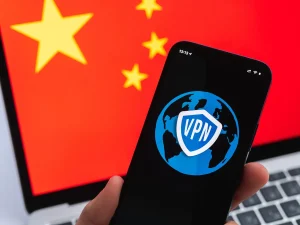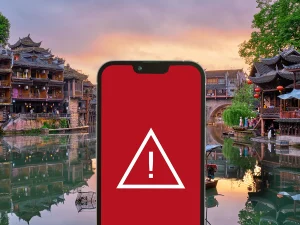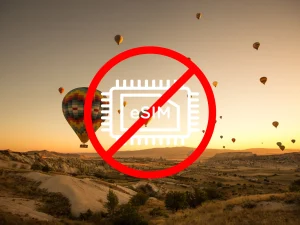A SIM (Subscriber Identity Module) is a small plastic card with a chip that, once inserted into mobile devices, allows connection to the network of the mobile operator that issued the SIM.
It contains essential information, such as the IMSI (International Mobile Subscriber Identity) and the ICCID (Integrated Circuit Card Identifier), a number that uniquely identifies the user on the mobile network.
Types of Physical SIM Cards
SIM cards have become progressively smaller. Millennials will certainly remember the shift from Mini SIM to Micro SIM, often involving manually cutting the plastic to fit the slots of the new smartphones of the time.
Let’s take a quick look at the three main SIM card formats used over the years:
- Mini SIM (2FF): The original standard-sized SIM card, used in older mobile phones (like the iconic Nokia 3310).
- Micro SIM (3FF): With the arrival of early smartphones, the SIM card size was reduced! Many providers offered SIMs with perforated outlines to choose the most suitable size, while some users opted to cut the SIM to fit.
- Nano SIM (4FF): The smallest and currently most common SIM format. The difference here lies not only in the width but also in the thickness, meaning you can’t simply cut down a larger SIM to make it a Nano SIM.
How a Physical SIM Works
Smartphones and mobile devices that connect to cellular networks have a built-in slot for SIM cards. Once the SIM is activated by your provider, inserting it into the device enables you to make calls, send messages, and access mobile data.
Installing a Physical SIM
Wondering how to install a physical SIM in your smartphone?
No worries, just follow these simple steps:
- Turn off your phone (not always necessary, but a good precaution).
- Eject the SIM tray. You’ll need the tool provided in your phone’s box, or you can use a paperclip or safety pin to press the small hole that releases the tray.
- Insert the SIM into the tray in the correct direction (look for the angled corner as a guide).
- Push the tray back into the phone carefully, making sure it’s flush with the phone’s frame.
- Turn your phone back on! The SIM will automatically connect to your operator’s network.
Using a Physical SIM Abroad
Can you continue using your SIM while traveling?
Absolutely! But you’ll need to enable international roaming, which allows your home operator to “interact” with local networks in the country you’re visiting. However, this often comes with very high costs that can quickly drain your balance.
Alternatively, you can buy a local SIM card, often sold at airports, but this means swapping your regular SIM (you’ll get a different phone number during your trip) and may face various limitations.
The perfect solution to avoid high roaming charges while keeping your phone number (for instance, to keep using WhatsApp) is to choose an eSIM, a virtual SIM that doesn’t require removing your physical SIM and offers incredibly flexible data plans.
Keep reading for a quick overview of eSIMs.
What is an eSIM?
An eSIM (Embedded SIM) is a digital SIM that is built directly into newer smartphones and doesn’t require a physical card. All the eSIM information is downloaded via software, making the process much faster and more flexible.
How Does an eSIM Work?
Just like a physical SIM, an eSIM connects your compatible device to a mobile network. The key difference is that the operator profile is downloaded and activated digitally—there’s no need to insert anything into your device.
Installing an eSIM
One of the greatest advantages of an eSIM is how quick and easy it is to install.
- Purchase an eSIM plan from a provider like eSIM.sm, choosing the most suitable data plan from a wide selection.
- Scan the QR-CODE sent via email upon purchase to begin the installation, or follow the instructions for manual setup.
- Upon arrival at your destination, simply ACTIVATE the eSIM already installed on your smartphone and start browsing without fear of roaming charges!
Benefits of Using an eSIM Abroad
Access to mobile internet while abroad is essential when planning a trip. Let’s break down the advantages of choosing an eSIM to stay connected during your travels:
- Fast & easy installation: Just a few clicks and your eSIM is ready to go.
- Flexibility: You can install multiple eSIMs on your device and have them ready for each leg of your journey (only one can be active at a time).
- Instant activation: Once installed, you just need to activate the eSIM before your flight or upon arrival.
- Keep your number: With eSIM.sm, you keep your original number, perfect for continuing to use WhatsApp to stay in touch with friends and family.
- Affordable: Avoid expensive roaming charges. eSIM.sm offers some of the most competitive rates on the market and a variety of data plans to fit your exact needs, no overspending!
Differences Between eSIM and Traditional Physical SIM
| Feature | eSIM | Physical SIM |
| Installation | Digital, via QR code | Requires requesting and manually inserting into device |
| Switching operators | Fast and easy via software | Requires changing the physical SIM card |
| Multiple profiles | Store multiple eSIMs on one device | Limited to two SIMs on dual-SIM phones |
| Size | Built-in, no space required | Requires physical slot in device |
| Use abroad | Instant activation upon arrival, easy top-up | Need to buy and swap for a local SIM |
Why Choose eSIM.sm?
Why go with eSIM.sm among so many eSIM providers out there? Here’s why:
- Coverage: Over 190 countries supported.
- Plan variety: On average, we offer 8 data plans per country to meet every budget and data need. We also have a Global Pay-As-You-Go Plan covering 150 countries with a single eSIM—ideal for frequent flyers!
- Simplicity: Just a few clicks to choose and purchase. Install by scanning the QR code received via email or follow the manual setup.
- Support: Our customer service is available 24/7 in multiple languages!
eSIM vs SIM: Which Should You Choose?
The right choice depends on your personal needs and the type of device you use. Some brands are starting to phase out physical SIMs altogether in their latest models. While these cases are still rare, when deciding between the two, consider:
- Compatibility: Not all devices support eSIM technology, though most newer smartphones do. Check this compatibility list to see if your device is supported.
- Travel frequency: If you travel to different countries frequently, eSIM is the best choice. If you repeatedly visit the same country, a local SIM might still be worth considering.
Now you’ve got all the information you need to choose between an eSIM and a physical SIM!
Pro tip for traveling, no matter your choice: save mobile data to make your plan last longer.








